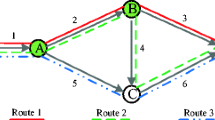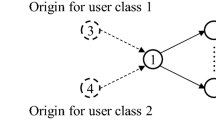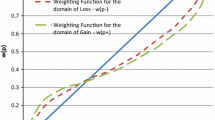Abstract
The replacement I-35W bridge in Minneapolis saw less traffic than the original bridge though it provided substantial travel time saving for many travelers. This observation cannot be explained by the classical route choice assumption that travelers always take the shortest path. Accordingly, a boundedly rational route switching model is proposed assuming that travelers will not switch to the new bridge unless travel time saving goes beyond a threshold or “indifference band”. Indifference bands are assumed to follow lognormal distribution and are estimated in two specifications: the first one assumes every driver’s indifference band is drawn from a population indifference band and the second one assumes that the mean of drivers’ indifference bands is a function of their own characteristics. Route choices of 78 subjects from a GPS travel behavior study were analyzed before and after the addition of the new I-35W bridge to estimate parameters. This study provides insights into empirical analysis of bounded rationality and sheds light on indifference band estimation using empirical data.







Similar content being viewed by others
References
Bekhor, S., Ben-Akiva, M.E., Ramming, M.S.: Evaluation of choice set generation algorithms for route choice models. Ann. Oper. Res. 144(1), 235–247 (2006)
Ben-Akiva, M., Boccara, B.: Discrete choice models with latent choice sets. Int. J. Res. Mark. 12(1), 9–24 (1995)
Ben-Akiva, M., Bolduc, D.: Multinomial probit with a logit kernel and a general parametric specification of the covariance structure. D’epartement d’economique, Universit’e laval with Department of Civil and Environmental Engineering, Massachusetts Institute of Technology (1996)
Ben-Akiva, M., Ramming, S.: Lecture notes: discrete choice models of traveler behavior in networks. Prepared for Advanced Methods for Planning and Management of Transportation Networks, Capri, Italy, 25 (1998a)
Cantillo, V., Heydecker, B., de Dios Ortúzar, J.: A discrete choice model incorporating thresholds for perception in attribute values. Transp. Res. Part B 40(9), 807–825 (2006)
Cantillo, V., Ortúzar, J.D.D., Williams, J.: Modeling discrete choices in the presence of inertia and serial correlation. Transp. Sci. 41(2), 195–205 (2007)
Carrion, C., Levinson, D. Route choice dynamics after a link restoration. In: Presented at Transportation Research Board Annual Meeting, Washington (2012)
Cascetta, E.: A stochastic process approach to the analysis of temporal dynamics in transportation networks. Transp. Res. Part B 23(1), 1–17 (1989)
Cascetta, E., Nuzzolo, A., Russo, F., Vitetta, A.: A modified logit route choice model overcoming path overlapping problems: specification and some calibration results for interurban networks. In: Proceedings of the 13th international symposium on transportation and traffic theory. pp. 697–711 (1996)
Clark, A.J.: The mode of action of drugs on cells (1933)
Cox, C.: Threshold dose-response models in toxicology. Biometrics 43, 511–523 (1987)
Daganzo, C.F., Bouthelier, F., Sheffi, Y.: Multinomial probit and qualitative choice: a computationally efficient algorithm. Trans. Sci. 11(4), 338–358 (1977)
Danczyk, A., Di, X., Liu, H., Levinson, D.: Unexpected cause, unexpected effect: Empirical observations of twin cities traffic behavior after the I-35W Bridge collapse and reopening. Transp. Policy (2015) (submitted)
Di, X., He, X., Guo, X., Liu, H.X.: Braess paradox under the boundedly rational user equilibria. Transp. Res. Part B 67, 86–108 (2014b)
Di, X., Liu, H.X.: Boundedly rational route choice behavior: a review of models and methodologies. Transp. Res. Part B 85, 142–179 (2016)
Di, X., Liu, H.X., Ban, X.J.: Second best toll pricing within the framework of bounded rationality. Transp. Res. Part B 83, 74–90 (2016)
Di, X., Liu, H.X., Pang, J.-S., Ban, X.J.: Boundedly rational user equilibria (BRUE): mathematical formulation and solution sets. Transp. Res. Part B 57, 300–313 (2013)
Di, X., Liu, H.X., Pang, B., Jeff, X., Yu, Jeong, Whon.: On the stability of a boundedly rational day-to-day dynamic. Netw. Spat. Econ. 15(3), 537–557 (2015)
Di, X.: Boundedly rational user equilibrium: models and applications. Ph.D. thesis, University of Minnesota (2014a)
Guilford, J.P.: Psychometric Methods (1954)
Guo, X., Liu, H.X.: Bounded rationality and irreversible network change. Transp. Res. Part B 45(10), 1606–1618 (2011)
Hemmingsen, A.M.: The accuracy of insulin assay on white mice. Q. J. Pharm. Pharmacol. 6, 39–80 (1933)
Hosmer, Jr., David, W., Lemeshow, S., Sturdivant, R.X., vol. 398. Wiley, New York
Hu, T.Y., Mahmassani, H.S.: Day-to-day evolution of network flows under real-time information and reactive signal control. Transp. Res. Part C 5(1), 51–69 (1997)
Jan, O., Horowitz, A.J., Peng, Z.-R.: Using global positioning system data to understand variations in path choice. Transp. Res. Rec. 1725(1), 37–44 (2000)
Jayakrishnan, R., Mahmassani, H.S., Hu, T.Y.: An evaluation tool for advanced traffic information and management systems in urban networks. Transp. Res. Part C 2(3), 129–147 (1994)
Jha, M., Madanat, S., Peeta, S.: Perception updating and day-to-day travel choice dynamics in traffic networks with information provision. Transp. Res. Part C 6(3), 189–212 (1998)
Jotisankasa, A., Polak, J.W.: Framework for travel time learning and behavioral adaptation in route and departure time choice. Transp. Res. Rec. 1985(1), 231–240 (2006)
Kaplan, S., Shiftan, Y., Bekhor, S.: Development and estimation of a semi-compensatory model with a flexible error structure. Transp. Res. Part B: Methodol. 46(2), 291–304 (2012)
Kaplan, S., Shiftan, Y., Bekhor, S.: Development and estimation of a semi-compensatory model incorporating multinomial and ordered-response thresholds. pp. 11–15 (2010)
Krishnan, K.S.: Incorporating thresholds of indifference in probabilistic choice models. Manag. Sci. 23(11), 1224–1233 (1977)
Levinson, D., Zhu, S.: The hierarchy of roads, the locality of traffic, and governance. Transp. Policy 19(1), 147–154 (2012)
Lioukas, S.K.: Thresholds and transitivity in stochastic consumer choice: a multinomial logit analysis. Manag. Sci. 30(1), 110–122 (1984)
Mahmassani, H.S., Chang, G.L.: On boundedly rational user equilibrium in transportation systems. Transp. Sci. 21(2), 89–99 (1987)
Mahmassani, H.S., Jayakrishnan, R.: System performance and user response under real-time information in a congested traffic corridor. Transp. Res. Part A 25(5), 293–307 (1991)
Mahmassani, H.S., Jou, R.C.: Transferring insights into commuter behavior dynamics from laboratory experiments to field surveys. Transp. Res. Part A 34(4), 243–260 (2000)
Mahmassani, H.S., Liu, Y.H.: Dynamics of commuting decision behaviour under advanced traveller information systems. Transp. Res. Part C 7(2–3), 91–107 (1999)
Martínez, F., Aguila, F., Hurtubia, R.: The constrained multinomial logit: a semi-compensatory choice model. Transp. Res. Part B 43(3), 365–377 (2009)
Morikawa, T., Miwa, T., Kurauchi, S., Yamamoto, T., Kobayashi, K.: Driver’s route choice behavior and its implications on network simulation and traffic assignment. Simulation Approaches in Transportation Analysis, pp. 341–369 (2005)
Prato, C., Bekhor, S.: Applying branch-and-bound technique to route choice set generation. Transp. Res. Rec. 1985(1), 19–28 (2006)
Ramming, M.S.: Network knowledge and route choice. Ph.D. thesis, Institute of Technology, MA (2001a)
Rasouli, S., Timmermans, H.: Models of bounded rationality under certainty, p. 1. Bounded Rational Choice Behaviour, Applications in Transport (2015)
Recker, W.W., Golob, T.F.: A non-compensatory model of transportation behavior based on sequential consideration of attributes. Transp. Res. Part B 13(4), 269–280 (1979)
Ridwan, M.: Fuzzy preference based traffic assignment problem. Transp. Res. Part C 12(3), 209–233 (2004)
Simon, H.A.: A behavioral model of rational choice. Q. J. Econ. 69(1), 99–118 (1955)
Simon, H.A.: Models of man: social and rational; mathematical essays on rational human behavior in a social setting (1957)
Srinivasan, K.K., Mahmassani, H.S.: Role of congestion and information in trip-makers’ dynamic decision processes: experimental investigation. Transp. Res. Rec. 1676(1), 44–52 (1999)
Swait, J.: A non-compensatory choice model incorporating attribute cutoffs. Transp. Res. Part B 35(10), 903–928 (2001b)
Swait, J., Ben-Akiva, M.: Incorporating random constraints in discrete models of choice set generation. Transp. Res. Part B 21(2), 91–102 (1987)
Tang, W., Levinson, D.: An empirical study of the deviation between actual and shortest travel time paths. In: Presented at the Transportation Research Board Conference, January 2016, Washington (2015)
Vovsha, P., Bekhor, S.: Link-nested logit model of route choice: overcoming route overlapping problem. Transp. Res. Rec. 1645(1), 133–142 (1998b)
Yanmaz-Tuzel, O., Ozbay, K.: Modeling learning impacts on day-to-day travel choice. In: Transportation and Traffic Theory. pp. 387–401 (2009)
Zhu, S.: Do people use the shortest path? an empirical test of wardrops first principle. PLoS One 10(8), e0134322 (2015)
Zhu, S., Levinson, D., Liu, H.X., Harder, K.: The traffic and behavioral effects of the I-35W Mississippi River bridge collapse. Transp. Res. Part A 44(10), 771–784 (2010)
Zhu, S.: The roads taken: theory and evidence on route choice in the wake of the I-35W Mississippi River bridge collapse and reconstruction. Ph.D. thesis, University of Minnesota (2011)
Zhu, S., Levinson, D.M., Disruptions to transportation networks: a review. In: Network Reliability in Practice. pp. 5–20 (2012)
Acknowledgments
The authors would like to thank the three anonymous referees for their insightful comments and constructive suggestions on the earlier version of the paper.
Author information
Authors and Affiliations
Corresponding author
Appendix
About this article
Cite this article
Di, X., Liu, H.X., Zhu, S. et al. Indifference bands for boundedly rational route switching. Transportation 44, 1169–1194 (2017). https://doi.org/10.1007/s11116-016-9699-1
Published:
Issue Date:
DOI: https://doi.org/10.1007/s11116-016-9699-1




